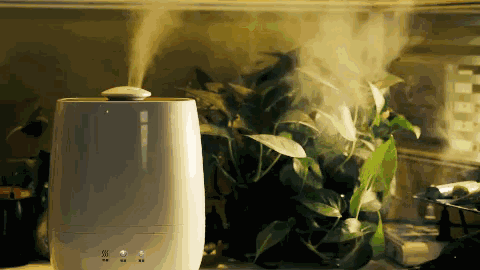
Some people say that the reason why winter is “difficult to endure”, not just because of the cold, but also a series of problems caused by dryness: cracked lips, dry skin, dry and itchy throat, full of static electricity…
In order to relieve dryness, humidifiers have become a must in many families. But it is this commonly used small electrical appliance, if used improperly, it will bring hidden dangers to health.

4 principles of using humidifier
In winter, the upper respiratory tract flora is more frequent than in summer, and it can easily cause pneumonia when entering the lungs. If the humidifier is used improperly, the resistance of the respiratory tract will decrease and the risk of infection will increase. Pay attention to the following points when using:
Choose one with less white fog when buying
When purchasing a humidifier, try to choose one with no white fog or less white fog.
In addition, you can also place your hand on the nozzle for about 10 seconds. If no water drops appear on the palm of your hand, it means that the most important part of the ultrasonic humidifier has a good uniformity of the transducer; otherwise, it indicates that the process is rough.

2 Don’t add “materials” randomly
Bactericide, vinegar, perfume and essential oil should not be added to the humidifier.
The tap water generally contains chlorine, so do not directly add it to the humidifier. It is recommended to use cool boiled water, purified water or distilled water with less impurities. If conditions are limited, you can put the tap water for a few days before adding it to the humidifier.
Clean once every two weeks
The humidifier cannot be cleaned regularly, and microbes such as mold and other microorganisms hidden inside will enter the room with the spray of air into the room, people with weak resistance are likely to cause pneumonia or respiratory infection.
It is best to change the water every day and clean it thoroughly every two weeks. The humidifier that is not used for a period of time should be cleaned thoroughly when first start-up.
Use less disinfectant when cleaning, you can rinse it repeatedly with running water, and then wipe off the scale around the water tank with a soft cloth.

4.0.5~1.5m high from the ground
The humidifier is best not to be too close to the human body, especially to the face, at least about 2 meters away from the human body. To ensure the humidification effect, the humidifier should be placed on a stable surface 0.5 to 1.5 meters above the ground.
It is best to place the humidifier in a well-ventilated place with moderate sunlight, and not close to home appliances and wooden furniture to prevent moisture.
The body loves this humidity best
If you want to use a humidifier, it is best to install a hygrometer at home to monitor the air humidity at any time.
Generally speaking, the human body adapts to a humidity of 40% to 70%, and when the air humidity is 45% to 65%, germs are not easy to spread.
When the humidity exceeds 80%, bacteria, dust mites, and mold are easy to breed, and people will feel stuffy. When condensation exists on walls, floors, desktops, etc, stop using the humidifier and open the window for ventilation, otherwise it may cause symptoms such as allergies and asthma.
If the humidity is lower than 30%, the mucous membrane will feel uncomfortable, such as dry skin, itchy eyes, dry nose and throat, you need to turn on the humidifier.
It is best not to keep the humidifier on all the time. It can be turned off for a period of time after two hours of opening.

Do 3 things to moisturize the body
In the dry winter, in addition to using a humidifier to moisturize, you can also do 3 things to save dry skin.
1 Eat the right food
To keep skin moisturized, eat more foods rich in vitamins:
Lack of vitamin A is manifested by dry and keratinized epidermis, protruding hair follicles, and dry eyes. Vitamin A is mainly found in liver, kidney, and fatty marine fish.
Beta carotene can be converted into vitamin A in the human body. You can eat more orange and dark green vegetables, such as carrots, pumpkins, spinach, and kale.
Lack of vitamin B2 can induce cheilitis, angular cheilitis, seborrheic dermatitis of the nose and face. Eat more milk, eggs, meat, animal organs, cereals, fruits and vegetables.
Vitamin C participates in the synthesis of collagen in the body and helps maintain healthy skin. Eat more fresh dates, sweet peppers, kiwi fruit and broccoli.

Foods rich in high-quality oils can also relieve dry skin:
The right amount of high-quality fat can keep the skin soft and smooth. Intake of nuts and seeds can supplement the body with such fats, such as walnuts and tahini.
What needs to be reminded is that this type of food should not be eaten too much to avoid the risk of getting fat.
Clean with warm water
Clean your hands and feet with warm water 2 to 3 times a day, which not only directly hydrates the skin, but also promotes metabolism and helps blood circulation.
Take care to avoid too frequent bathing in winter, do not use overheated water, should be around 40 ℃, and do not over-rub, try to use alkaline soap or shower gel as little as possible.
Generally, after cleansing and bathing, you can use lotion to lock in moisture.
Apply some ointment
If the skin is too dry and cracked, consider applying some ointment while moisturizing it.
Less rupture (small incision, light pain)
After soaking with warm water every day, apply a layer of oily ointment. The protection of the lipid film can reduce the loss of water in the skin and make the skin moisturized.
Severely broken
When the skin is severely broken, 10~15% urea ointment and 5~10% salicylic acid ointment can be applied locally on the broken skin. When the dryness is relieved, wash hands and feet with warm water or apply oily ointment every day.
Comments